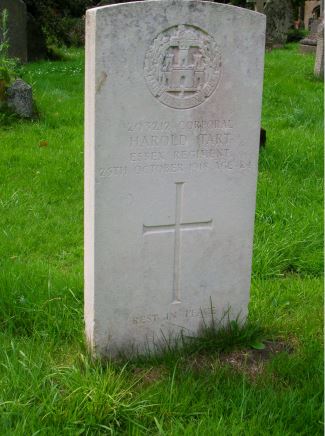2nd Battalion, Essex Regiment

Harold Tart was a Staffordshire man who came to marry a girl from Mickleton, the most northerly village in Gloucestershire.
He was born in Wallbrook, near Sedgeley, Staffordshire in 1894. His father, John Edward Tart (1859-1921) was a coal miner and his mother was Mary Jane (née Clare; 1862-1911). The couple had eight children.
At the time of the 1901 Census the family home was at 10 Bissell Street, Sedgeley. Ten years later the census of 1911 shows John Edward Tart living at 2 Bissell Terrace, Wallbrook, along with three of his sons, one of whom was Harold. Their mother had died just previous to the census date. Harold’s occupation was shown as an iron works moulder but he was unemployed at that time.
Unfortunately, no Army Service or Pension Record has survived to give details of Harold’s Army service. From records that have survived it is possible to put forward a reasonable hypothesis regarding his military career.
Harold initially joined the 1/6th Battalion of the South Staffordshire Regiment; a fact confirmed by his entry in the Medal Entitlement Roll and confirmed in Soldiers Died in the Great War (SDGW). This was a Territorial Force unit formed in the Drill Hall, Wolverhampton, on 4 August 1914. SDGW states that he enlisted at Wolverhampton and his low Army number, 2590, as an indicator that he was an early war volunteer. His Medal Rolls Index Card notes that he first went abroad (to the Western Front) on 5 March 1915, which coincides with the battalion’s first posting abroad. In May 1915 the battalion became part of 137 Brigade, 46 Division.
On 1 July 1916, the opening day of the Somme Offensive, 46 Division took part in a three divisional diversionary attack on the village of Gommecourt. The 1/6th South Staffordshires were badly mauled, losing 236 casualties in the opening minutes. Although this cannot be verified, it is reasonable to speculate that Harold Tart was one of those wounded in this action and was repatriated to England. He may have spent a considerable time recovering from his injuries; where we do not know.
Possibly it was in Gloucestershire, as on 30 June 1917, aged 25, he married 21 year old Elsie Fletcher at Mickleton. Their marriage certificate states that he was a soldier, located at Ripon. The couple had one child, Sylvia Elsie, born on 29 March 1918.
By 1917, soldiers who had fallen sick or had been wounded did not automatically return to their original unit, when declared fit for duty. They were assigned to which ever unit was in need of them, to replace casualties. On occasion, blocks of men transferred to other units, to top up their strength.
It is known that Corporal Harold Tart transferred to the 2nd Battalion, Essex Regiment, where he would have received a new number (203212). Examination of SDGW shows that men serving with the 2nd Essex with numbers 203212, 203214, 203215 and 203216 all previously served with the 1/6th South Staffordshires – so maybe Harold was part of the transfer of a block of men.
A recently released Pension Record Card (PRC) states that Harold Tart died as a result of influenza and pneumonia contracted on active service: it is almost certain he was a victim of the second wave of ‘Spanish Flu’ raging at the time.
Corporal Harold Tart died in Norton Hall Hospital, Cheltenham on 25 October 1918, aged 25. The PRC gives several addresses for him and his widow: 51 Linden Road, Redland (Bristol); 24 Church Road, Northfield, Birmingham and Mythe Bridge, Tewkesbury. Elsie Tart re-married in July 1923, becoming Mrs Roberts and the CWGC Register gives her address as Clark’s Alley, High Street, Tewkesbury.
No report of Harold Tart’s funeral has been discovered in the local press of the time. His death was reported in the War Office Weekly Casualty List of 7 January 1919. He was buried in the churchyard of St Lawrence, Mickleton, where a standard CWGC headstone now marks his grave.
Researched by Graham Adams 2 October 2020
